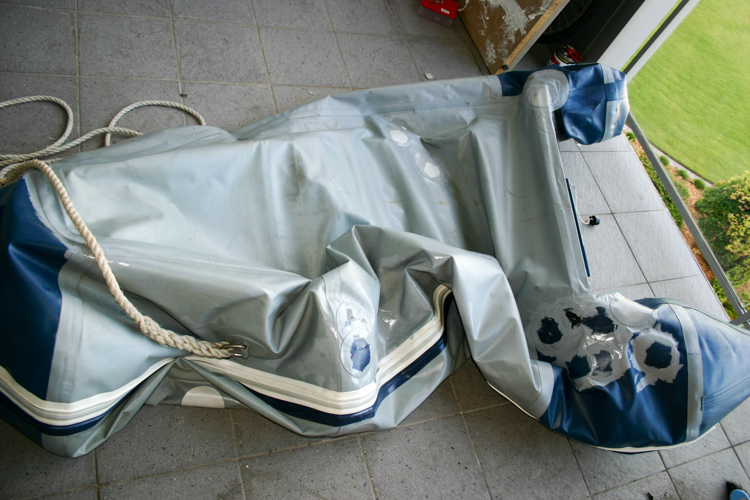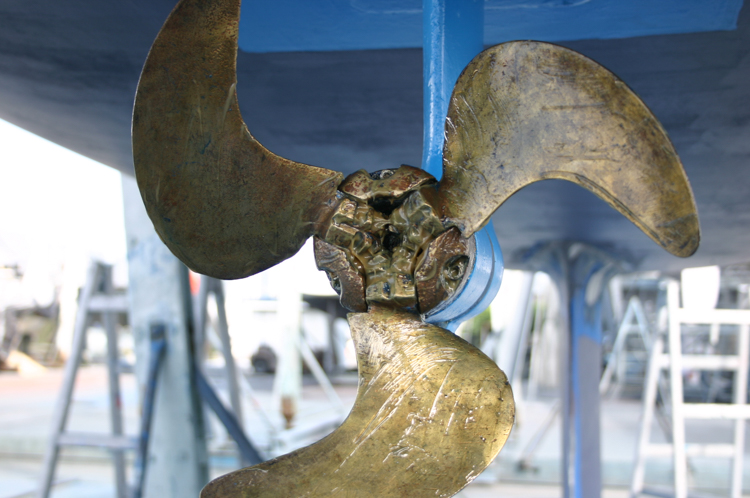Pindimara came equipped with a neat three-blade folding propeller, designed to collapse in on itself when under sail in order to reduce drag. It was supposed to be nice shiny brass, but in fact bore a closer resemblance to an old hub cap that had been languishing in a coral reef.
We were up on the hard for our first antifoul, so I had a brief window to work on dry land. Wielding a wire brush on an angle-grinder, I made short work of all the white stuff, and then took the whole thing apart and greased it and reassembled it with a liberal coating of lanolin, which looked great but made me smell like an old sheep. Then I painted the sail drive itself with several coats of special aluminium-friendly light blue paint, and stood back to admire my handywork.
Lovely, it was. A work of art.
On the Monday morning after our weekend of anti-fouling, we were up bright and early to supervise Pindimara’s return the water. It was raining heavily when we arrived, and we couldn’t find any of the slipway staff; presumably they were all hiding somewhere dry and wouldn’t answer their radios, so we had to go to work and hope that they’d reappear and put her back in the water later that day.
In the evening, we turned up once again and there she was waiting for us, tied up to the fuel dock. While Bronwyn drove the car around the bay to our home marina, I motored off into Pittwater to meet her. Once in the open water, I couldn’t resist opening the throttle to see what would happen.
Before we started this work, she would barely make one knot under power. Four knots… five knots… six knots… seven knots. Incredible, and very, very smooth. Pretty happy, I steered through the moored boats in the falling dusk to the marina dock, where I could vaguely see Bronwyn standing on the deck, and the low shape of the Zodiac in the water beside her.
The tide was low, and the flow was opposed to the rain and wind. I had to be careful in my approach, and so nosed up ever so carefully, squinting in the dying light. Then, suddenly, the engine hammered loudly under my feet, and I couldn’t get any control.
I managed to swing away from the shore, and came back around for another try. Had I hit the bottom? Was I tangled in fishing line? Bronwyn waited, puzzled, on the dock as the boat ran around in circles. I really couldn’t make any sense of what was happening; steering and power seemed to come and go at random. Finally I got the nose up to Bronwyn, who hopped aboard, trailing the tender behind her.
Immediately I put on the power to prevent the current from ramming us into the dock, and although the bow peeled away, it still all felt very wrong. We were almost around and clear when the engine started banging again and the yacht started to crab mysteriously sideways toward an oyster-encrusted piling. I glanced back; if I let off the power, the stern would connect with the dock; if I did nothing, we would hit the piling.
Bronwyn stood on the pulpit, shouting something, and I realised that she still had the tender’s painter in her hand. I could only see one solution; I hit the power, the engine slammed up against the soles of my feet, and the yacht ploughed into the Zodiac inflatable and crushed it against the razor-sharp oyster shells. Seconds later, we bounced free. I killed the power, and watched as the crushed remains of our tender bobbed sadly to the surface, remarkably still afloat despite the slashes down its side.
Getting to the mooring was hard work with little in the way of power or steering, and eventually we realised that we would have to stay the night and sort it out in the morning, because there was no way that we were rowing back to shore in half a tender.
Morning came. The tender looked bad in the light of day, but thankfully the yacht had sustained no hull damage at all. With a slack tide and no wind, we motored around a bit trying to figure out what was wrong, but in the end crabbed our way to the water dock and asked a local firm of engineers to take a look.
Later that day, I got a phone call. They’d sent a diver down, and apparently one of the blades of our shiny beautiful folding propeller was twisted backwards, giving us two thirds forward motion and one third backward. No wonder the engine was banging! The poor thing was trying to jump up through the hull with the forces that were being applied to it. I asked the engineers to take her back up onto the slip and fit our emergency backup prop so that we could take a look at the old one. Deeply embarrassed, I could only think that I’d somehow fitted one of the blades backward, and I couldn’t understand how that was possible.
Once we got hold of the failed prop, it became clear that I hadn’t been immediately to blame. The brass teeth that work the folding mechanism were old and worn, and in the final analysis, the layer of coral that I had so diligently removed was all that had been holding the thing together. The prop would have failed eventually, but cleaning it up had hastened the day.

Squashed
